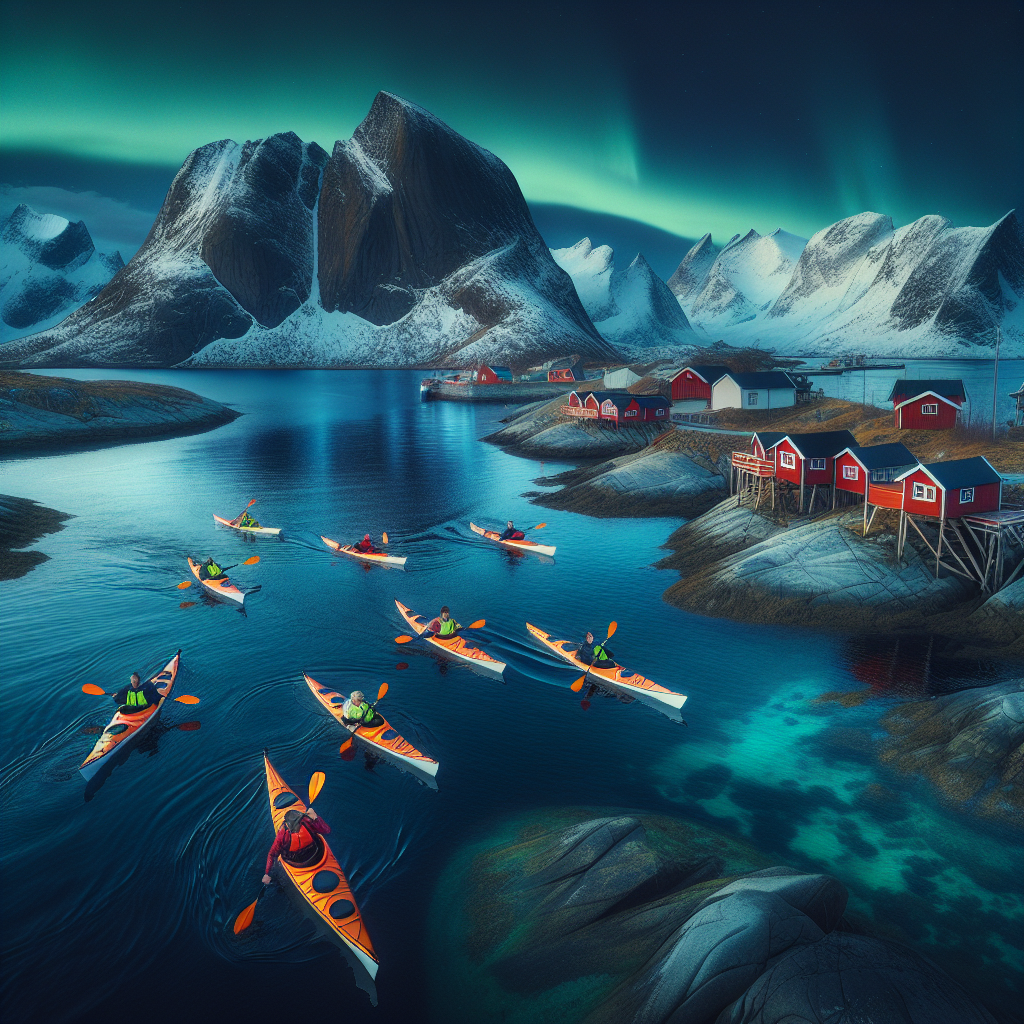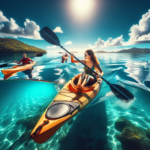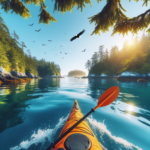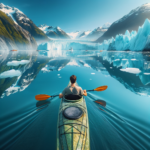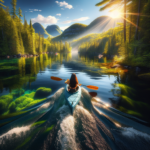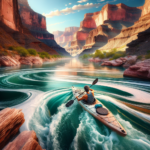Kayaking in Lofoten Islands, Norway
Introduction to Kayaking
Kayaking is a thrilling outdoor activity that has gained immense popularity worldwide. It offers a unique way to explore nature, providing an intimate experience with water bodies, whether they be rivers, lakes, or seas. The sport is accessible to people of all skill levels, from beginners to seasoned paddlers, making it a versatile and inclusive activity. The sense of adventure and the physical challenge it presents are just a few reasons why kayaking has become a favorite pastime for many.
In this article, we will spotlight the Lofoten Islands in Norway, a destination that stands out for its exceptional kayaking opportunities. We will delve into the unique features that make this location a must-visit for kayaking enthusiasts. From its stunning geography to its rich cultural history, the Lofoten Islands offer a kayaking experience like no other.
Kayaking in the Lofoten Islands is not just about paddling through water; it’s about immersing yourself in a landscape that is both rugged and serene. The islands’ dramatic cliffs, crystal-clear waters, and abundant wildlife create a backdrop that is both breathtaking and humbling. Whether you’re a novice or an expert, the Lofoten Islands offer something for everyone.
So, what makes kayaking in the Lofoten Islands so unique? It’s a combination of the natural beauty, the challenging yet rewarding water conditions, and the sense of adventure that comes with exploring such a remote and pristine environment. Let’s dive deeper into what makes this destination a kayaking paradise.
Overview of Kayaking in Lofoten Islands, Norway
The Lofoten Islands are an archipelago located in the northern part of Norway, above the Arctic Circle. Known for their dramatic scenery, the islands feature towering mountains, deep fjords, and long stretches of pristine beaches. The geography of the Lofoten Islands is a kayaker’s dream, offering a variety of landscapes to explore, from sheltered bays to open sea passages.
The climate in the Lofoten Islands is relatively mild, thanks to the Gulf Stream, which keeps the waters warmer than you might expect for such a northern location. Summers are the best time to visit, with long daylight hours and relatively calm seas. However, the islands can be visited year-round, each season offering its own unique charm and challenges.
Historically, the Lofoten Islands have a rich connection to water sports and maritime activities. The local culture is deeply intertwined with the sea, from traditional fishing practices to modern-day water sports like kayaking. This cultural heritage adds an extra layer of depth to your kayaking experience, making it not just an adventure but also a journey through time.
Accessing the Lofoten Islands is relatively straightforward. The islands are connected to the mainland by a series of bridges and tunnels, and there are regular ferry services. The nearest airport is in Svolvær, the largest town in the archipelago, which offers flights from major Norwegian cities. Once you arrive, you’ll find that the islands are well-equipped to cater to tourists, with plenty of amenities and services to make your stay comfortable.
Kayaking Conditions in Lofoten Islands, Norway
The waters around the Lofoten Islands are primarily part of the Norwegian Sea, offering a mix of sheltered bays and open sea conditions. This variety makes it an ideal location for kayakers of all skill levels. Beginners can stick to the calmer, more protected areas, while experienced paddlers can venture out into the more challenging open waters.
The weather in the Lofoten Islands can be quite variable, even in the summer months. It’s essential to check the weather forecast before heading out and to be prepared for sudden changes. Summer temperatures range from 10°C to 15°C (50°F to 59°F), while winter temperatures can drop below freezing. The wind can also be a significant factor, especially in the open sea areas.
Tides and currents are another important consideration when kayaking in the Lofoten Islands. The tidal range can be quite substantial, affecting water levels and currents. It’s crucial to be aware of the tide schedules and to plan your trips accordingly. Local guides and rental shops can provide valuable information on the best times to paddle.
Environmental factors such as water temperature and visibility also play a role in your kayaking experience. The water is generally cold, even in summer, so wearing appropriate gear like a wetsuit or drysuit is recommended. Visibility can vary, but the waters are often clear, allowing you to see the underwater landscape and marine life, adding another layer of enjoyment to your kayaking adventure.
Top Spots for Kayaking in Lofoten Islands, Norway
One of the top spots for kayaking in the Lofoten Islands is the Reinefjorden. Known for its stunning scenery, this fjord offers calm waters and breathtaking views of the surrounding mountains. It’s an excellent spot for beginners and those looking to take in the natural beauty of the area without too much physical exertion.
Another must-visit location is the Trollfjord, a narrow fjord that is famous for its dramatic cliffs and crystal-clear waters. The fjord is relatively short but offers a challenging paddle due to its narrowness and the potential for strong currents. It’s a favorite among more experienced kayakers looking for a bit of a challenge.
The island of Skrova is another fantastic kayaking destination. Known as the “Hawaii of the North,” Skrova offers beautiful beaches and excellent opportunities for wildlife spotting. The waters around Skrova are relatively calm, making it a great spot for a leisurely paddle and a picnic on one of its many beaches.
For those looking for a more remote and rugged experience, the waters around the island of Værøy offer a unique challenge. The island is located further out in the archipelago and is less frequented by tourists. The waters here can be more challenging, with stronger currents and more exposed conditions, making it ideal for experienced kayakers looking for an adventure.
Safety and Regulations
Safety is paramount when kayaking in the Lofoten Islands. Local regulations require all kayakers to wear a life jacket at all times. It’s also recommended to carry a whistle, a waterproof map, and a first aid kit. Knowing how to perform a self-rescue and having basic first aid skills can be lifesaving in an emergency.
Weather conditions can change rapidly in the Lofoten Islands, so it’s crucial to check the forecast before heading out. Inform someone of your plans and expected return time. Mobile phone coverage can be spotty in some areas, so consider carrying a VHF radio for emergency communication.
It’s also essential to be aware of local wildlife and to keep a safe distance. Seals, sea birds, and even whales can be encountered while kayaking. Disturbing wildlife can not only be dangerous but also harmful to the animals. Always follow local guidelines and respect the natural habitat.
In case of an emergency, knowing how to signal for help is crucial. A whistle or a signal mirror can be used to attract attention. If you’re kayaking in a group, stay close together and keep an eye on each other. Local guides and rental shops often provide safety briefings and can offer valuable advice on how to handle emergency situations.
Amenities and Accommodations
The Lofoten Islands are well-equipped to cater to tourists, with a range of amenities and accommodations available. Several rental facilities offer kayaks, paddles, and safety gear. Guided tours are also available, providing an excellent way to explore the islands with the added benefit of local knowledge and expertise.
Accommodation options in the Lofoten Islands range from camping sites to luxury hotels. For those looking to immerse themselves in nature, several campgrounds offer stunning views and easy access to kayaking spots. If you prefer more comfort, there are numerous hotels and lodges that provide all the amenities you need for a relaxing stay.
In addition to kayaking, the Lofoten Islands offer a variety of other recreational activities. Hiking, fishing, and bird watching are popular options for days when you’re not on the water. The islands are also known for their vibrant arts scene, with several galleries and museums showcasing local talent and history.
Dining options are plentiful, with many restaurants offering fresh seafood and traditional Norwegian cuisine. After a day of kayaking, there’s nothing better than enjoying a delicious meal while taking in the stunning views of the islands. Whether you’re looking for a quick bite or a gourmet dining experience, you’ll find plenty of options to satisfy your appetite.
Environmental Considerations
Preserving the natural beauty and wildlife of the Lofoten Islands is of utmost importance. Eco-friendly kayaking practices are essential to minimize your impact on the environment. Always follow the “Leave No Trace” principles, which include packing out all trash, avoiding disturbing wildlife, and staying on designated paths and campsites.
Using biodegradable soap and avoiding single-use plastics are simple ways to reduce your environmental footprint. When kayaking, be mindful of your surroundings and avoid disturbing marine life. If you encounter wildlife, keep a safe distance and observe quietly without causing any stress to the animals.
Several local conservation efforts and projects aim to protect the unique ecosystems of the Lofoten Islands. Visitors can support these initiatives by participating in beach clean-ups, donating to local conservation organizations, or simply by following eco-friendly practices during their stay. Every little bit helps in preserving this pristine environment for future generations.
By choosing eco-friendly accommodations and supporting local businesses that prioritize sustainability, you can contribute to the conservation efforts in the Lofoten Islands. Many tour operators and rental facilities are committed to sustainable practices, so be sure to inquire about their environmental policies when planning your trip.
Highlights
When comparing kayaking in the Lofoten Islands to other popular kayaking destinations, several unique features stand out. The archipelago’s dramatic landscapes, with towering mountains and deep fjords, offer a kayaking experience that is both visually stunning and physically challenging. The clear, cold waters provide excellent visibility, allowing kayakers to see the underwater world in detail.
The biodiversity of the Lofoten Islands is another highlight. The waters are home to a variety of marine life, including seals, sea birds, and even whales. The islands themselves are rich in flora and fauna, making every kayaking trip an opportunity for wildlife spotting and nature appreciation.
Geographically, the Lofoten Islands are unique due to their location above the Arctic Circle. This means that during the summer months, you can experience the Midnight Sun, where the sun never sets, providing extended daylight hours for kayaking. In the winter, the Northern Lights offer a magical backdrop for those brave enough to paddle in colder conditions.
Historically, the Lofoten Islands have a deep connection to maritime activities, from traditional fishing practices to modern water sports. This rich cultural heritage adds an extra layer of depth to your kayaking experience, making it not just an adventure but also a journey through time. The combination of natural beauty, biodiversity, and cultural significance makes kayaking in the Lofoten Islands a truly unique experience.
FAQ Section
- What is the best season to go kayaking in the Lofoten Islands? The best season is summer, from June to August, due to the mild weather and long daylight hours.
- Are there beginner-friendly spots for kayaking? Yes, Reinefjorden and Skrova offer calm waters suitable for beginners.
- What should I bring for a kayaking trip? Essential items include a life jacket, wetsuit or drysuit, waterproof map, first aid kit, and a whistle.
- Are kayak rentals available? Yes, several rental facilities offer kayaks and safety gear. Prices vary depending on the duration and type of kayak.
- How can I participate in local conservation efforts? You can join beach clean-ups, donate to local conservation organizations, and follow eco-friendly practices during your stay.
- Are guided kayaking tours available? Yes, guided tours are available and cover various routes, providing local knowledge and ensuring safety.
- What safety measures are in place? Local regulations require wearing a life jacket at all times. It’s also recommended to carry a whistle, waterproof map, and first aid kit.
Final Thoughts
Kayaking in the Lofoten Islands, Norway, is a premier destination for kayaking enthusiasts. The combination of stunning natural beauty, diverse wildlife, and rich cultural heritage makes it a unique and unforgettable experience. Whether you’re a beginner or an experienced paddler, the Lofoten Islands offer something for everyone.
It’s essential to respect local guidelines and conservation efforts to preserve this pristine environment for future generations. By following eco-friendly practices and supporting local conservation initiatives, you can help protect the natural beauty and wildlife of the Lofoten Islands.
In conclusion, kayaking in the Lofoten Islands is more than just an adventure; it’s an opportunity to connect with nature and immerse yourself in a landscape that is both rugged and serene. The sense of accomplishment and the memories you’ll create are well worth the effort.
So pack your gear, plan your trip, and get ready to explore the breathtaking beauty of the Lofoten Islands. Whether you’re paddling through calm fjords or challenging open waters, the experience will leave you with a newfound appreciation for the natural world and the thrill of kayaking.

